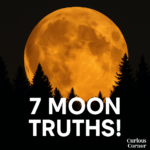
But are you really seeing it—or just staring at a glowing mystery? 🌕
Moonlight ke peeche chhupi 7 jaw-dropping sachchaiyaan ab saamne aane wali hain. Read this before the next full moon rises!
🌙 1. What Is this Illusion?
The moon looks huge near the horizon—but it’s not.
This is a brain trick called the Moon Illusion.
When near trees or buildings, our mind thinks it’s massive.
Reality? It’s the same size always.
🌙 2. Why this planet Turned Golden in 2025
In June 2025, the full moon turned a gorgeous golden-orange.
It wasn’t magic—it was atmospheric science!
When the moon is low, it filters through more air, scattering blue light and letting warm tones dominate.
🌙 3. The Moon’s Mysterious Low Path
June 2025 brought the lowest🌙 in almost 20 years!
This rare phenomenon made the planet hug the horizon—
appearing larger, brighter, and even more haunting.
Kya aapne dekha ya miss kar diya?
🌙 4. 18-Year Lunar Standstill Magic
Every 18.6 years, the moon does something wild—
it rises and sets at extreme positions.
This is called the major lunar standstill.
Next chance? 2043. Kal tak ka intezaar mat karna!
🌙 5. Ancient Names, Timeless Vibes
The moon has names!
In June, it’s the Strawberry Moon (Native American),
Vat Purnima in India, and more.
Cultures use moon phases for festivals, farming, and even love!
6. Capture the Moon Like a Pro
📸 Photography Hack Time:
-
Tripod? Must.
-
ISO: 100–400
-
Shutter speed: 1/125s
-
Shoot during moonrise for orange hues
-
Add a silhouette—tree, dome, ya tower!
🌙 7. It Met Antares: Cosmic Chemistry!
In June 2025, this planet cozied up next to Antares,
a giant red star in the Scorpius constellation.
It was a celestial pairing, making skywatchers gasp across India!
👉 Check out our Beginner’s Guide to Stargazing only on Curious Cornor.
NASA knows its moons!
🌐 Visit Phases & Eclipses of chand – NASA for official space data.
Toh agli baar jab chand ko dekho, sirf roshni mat dekho—
dekho uske andar chhupi kahaniyaan, gyaan, aur glam ✨
Because chand ? It’s not just a rock…
It’s the universe’s biggest drama queen—and now, you’re in on her secrets.
🌌 Accurate Data About Earth’s Natural Satellite
🪐 Basic Astronomical Data
| Parameter | Accurate Value & Description |
|---|---|
| Name (Scientific) | Luna (Latin name) |
| Type | Natural satellite |
| Distance from Earth | Approx. 384,400 km (238,855 miles) |
| Orbital Period | 27.3 days (sidereal); 29.5 days (synodic cycle or “lunar month”) |
| Diameter | ~3,474 km |
| Surface Gravity | 1.62 m/s² (about 1/6th of Earth’s gravity) |
| Mass | 7.35 × 10²² kg |
| Surface Temperature | Ranges from -173°C to +127°C |
| Atmosphere | Exosphere (extremely thin; almost vacuum) |
| Rotation Type | Synchronous rotation (always shows the same face to Earth) |
| Light Travel Time | Light from its surface takes about 1.3 seconds to reach Earth |
🌑 Surface & Geology
- This celestial companion is covered in regolith, a mix of fine dust and rocky debris.
- It has no liquid water on the surface, but ice exists in permanently shadowed craters.
- Contains basalt plains called maria and highland regions with craters billions of years old.
🌠 Exploration Milestones
- First human landing: Apollo 11 (Neil Armstrong, July 20, 1969)
- First spacecraft impact: Luna 2 (Soviet Union, 1959)
- Latest missions:
- India’s Chandrayaan-3: Successfully soft-landed near the south polar region (2023)
- Artemis Program (NASA): Planned crewed missions starting late 2020s
🌊 Tidal & Earth Impact
- This orbital partner causes ocean tides due to its gravitational pull.
- It stabilizes Earth’s axial tilt, crucial for maintaining seasonal balance and climate over millennia.
🧊 Confirmed Discoveries
- Water molecules found on the sunlit surface by NASA’s SOFIA observatory (2020).
- Presence of helium-3, a rare isotope with potential use in nuclear fusion energy.
